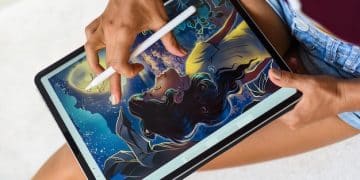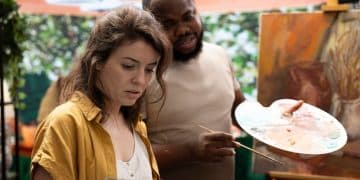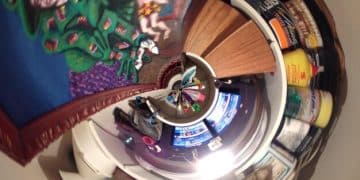Master Procreate in 3 Months: Digital Art Guide for US Beginners
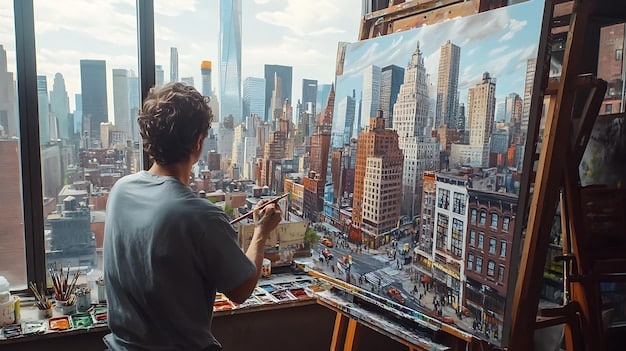
Mastering digital art on Procreate within three months is an ambitious yet achievable goal for US beginners, requiring structured practice, focused learning, and consistent application of core artistic principles combined with Procreate’s powerful features.
Embarking on a journey to master digital art can seem daunting, but with the right tools and a structured approach, significant progress is attainable. For aspiring artists in the United States, learning to wield 3 Months to Master Digital Art: A Beginner’s Guide to Procreate in the US offers a clear path to unlocking creative potential. This comprehensive guide will equip you with the knowledge and strategies to navigate Procreate’s features, cultivate essential artistic skills, and confidently create stunning digital artwork within a focused three-month period.
Setting the Stage: Your First Month with Procreate
The initial month is crucial for building a solid foundation. Instead of diving headfirst into complex projects, focus on understanding the core functionalities of Procreate and familiarizing yourself with fundamental art concepts. Think of it as learning the alphabet before writing a novel.
Many beginners overlook the importance of muscle memory and interface familiarity. Your iPad and Apple Pencil are extensions of your hand, and Procreate is your canvas. Spend dedicated time simply exploring the app’s layout, menus, and customizable settings. This seemingly simple step will save you countless hours of frustration later on.
Understanding the Interface and Basic Tools
Procreate’s interface is designed to be intuitive, but its depth can surprise new users. Start with the basics: canvases, layers, and brushes. Creating and managing layers is perhaps the single most important skill to master early. It allows for non-destructive editing and immense flexibility in your workflow.
- Canvas Setup: Learn to create canvases with appropriate resolutions and dimensions for your projects (e.g., standard print sizes, web graphics).
- Layer Management: Understand how to add, delete, merge, duplicate, and group layers. Experiment with blend modes to see how layers interact.
- Brush Exploration: Procreate comes with an extensive library of brushes. Don’t feel overwhelmed; focus on a few basic ones like sketching pencils, inking pens, and a soft airbrush.
Alongside these technical skills, dedicate time to basic drawing exercises. Practice drawing straight lines, perfect circles, and various geometric shapes. These exercises, though simple, drastically improve your hand-eye coordination and control over the Apple Pencil. Remember, consistency is key; even 15-20 minutes of daily practice can yield impressive results.
Mastering Fundamental Art Principles
Digital art still relies heavily on traditional art principles. During your first month, introduce yourself to concepts like perspective, composition, and basic color theory. There are countless free resources online, from YouTube tutorials to blogs, that break down these concepts into digestible lessons.
Don’t strive for perfection at this stage; aim for understanding and application. Sketch simple objects, focusing on their forms and how light interacts with them. This is where your chosen basic brushes come into play, helping you block out shapes and add initial shading. Regularly review your work, identifying areas for improvement, and don’t be afraid to redo exercises.
Month Two: Building Skills and Exploring Techniques
Having established a foundational understanding, your second month should be dedicated to deepening your technical skills and experimenting with more advanced Procreate features. This is where you start bringing complexity and personal style into your work.
Move beyond basic studies and begin applying what you’ve learned to simple illustrations or character designs. The goal here is to integrate your knowledge of Procreate’s tools with your growing understanding of art principles. Think of small, achievable projects that challenge you without overwhelming you.
Advanced Procreate Features and Workflow
Procreate offers a plethora of tools that can dramatically enhance your workflow and artistic output. This month, delve into features like Alpha Lock, Clipping Masks, Selection Tools, and Reference Layers. These tools provide precision and efficiency, crucial for more polished artwork.
- Alpha Lock and Clipping Masks: Learn to color within lines or apply textures non-destructively.
- Selection Tools: Master the freehand, automatic, and rectangular selections to isolate and manipulate parts of your artwork.
- Reference Layers: Utilize reference images within your artwork for precise color picking or to help with anatomical accuracy.
Experiment with different brush sets. Procreate’s default brushes are excellent, but exploring custom brushes (many available for free or purchase) can open up new textural possibilities. Try digital painting exercises that focus on blending colors smoothly or creating dynamic line art. The more you experiment, the more you’ll understand what works best for your style.
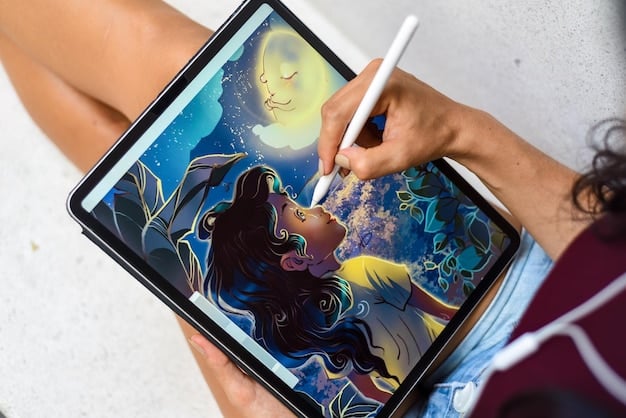
Color Theory in Practice and Lighting
Color is a powerful tool in art, capable of evoking emotions and defining mood. Expand your knowledge of color theory by studying color harmony, contrast, and saturation. Practice creating color palettes and using them consistently in your artwork. Pay attention to how different colors interact and influence each other.
Lighting is another critical element that adds depth and realism. Learn about different light sources (e.g., directional, ambient, rim light) and how they cast shadows and create highlights. Practice rendering simple objects under various lighting conditions. This will significantly improve the three-dimensionality of your drawings and paintings. Spend time analyzing real-world photographs or classical paintings to see how master artists handle light and shadow.
Month Three: Refining Your Style and Project Completion
Your final month is about consolidating your skills, developing a personal style, and completing more ambitious projects. By now, you should feel comfortable navigating Procreate and applying core art principles. This is the time to push your boundaries and express your unique vision.
Focus on creating a few complete pieces that showcase your progress. These could be character illustrations, landscape digital paintings, or even a short comic strip. The act of completing a project, from concept to final touches, is invaluable for learning and confidence building.
Developing Personal Style and Advanced Techniques
Every artist eventually develops a unique style. This month, pay attention to the colors, textures, and themes that resonate most with you. What kind of art do you enjoy creating? What visual language do you want to convey? Experiment with different artistic styles, mimicking artists you admire, to understand their approaches before developing your own distinct voice.
- Compositional Mastery: Focus on dynamic compositions that lead the viewer’s eye.
- Texturing: Integrate custom brushes and Procreate’s texture overlays to add depth and realism to your surfaces.
- Gradients and Special Effects: Learn to use gradient maps, gaussian blur, motion blur, and other effects to enhance atmosphere and focus.
Consider diving into advanced techniques like animation assist for simple GIFs, or exploring the transform tools for quick adjustments. Learning to refine your lines, blend colors seamlessly, and add intricate details will elevate the quality of your work. Seek feedback from online communities or fellow artists; constructive criticism is a powerful tool for growth.

Project Planning and Execution
For your final projects, dedicate time to planning before you even touch the Apple Pencil. This includes sketching thumbnails, defining your color palette, and gathering reference images. A well-planned project is often a successful project, saving time and reducing frustration during the execution phase.
Work on multiple pieces simultaneously if that helps maintain variety and prevents burnout. Don’t be afraid to step away from a piece and return with fresh eyes. The goal isn’t just to finish, but to apply all the knowledge and skills you’ve acquired over the past three months. Celebrate your achievements, no matter how small, and use each completed piece as a stepping stone to your next artistic challenge.
Troubleshooting Common Beginner Hurdles
Even with a structured plan, you’re bound to encounter challenges. It’s an inevitable part of the learning process. The key is to approach these hurdles with patience and a problem-solving mindset, rather than letting them derail your progress.
One common issue for beginners is understanding brush dynamics. It’s not just about selecting a brush, but about understanding its pressure sensitivity, tilt, and how it interacts with the canvas. Spend time testing each brush, noting its unique characteristics and how to best utilize it for different effects. Many artists keep a dedicated canvas just for brush testing.
Overcoming Creative Blocks and Frustration
Creative blocks are a universal experience. When inspiration wanes or frustration mounts, take a break. Step away from your iPad, go for a walk, or engage in another creative activity. Sometimes, simply looking at art from different perspectives can reignite your spark.
- Reference Abundantly: Don’t be shy about using photo references for anatomy, lighting, and textures.
- Daily Sketching: Even quick, rough sketches can keep your creative muscles warm and ideas flowing.
- Community Engagement: Share your work and connect with other artists online. Their encouragement and advice can be invaluable.
It’s also important to manage expectations. You won’t become a master overnight (or even in three months!). Focus on consistent improvement and enjoying the process. Every perceived “failure” is a learning opportunity. Analyze what went wrong, research solutions, and apply those lessons to your next attempt. Perseverance is as crucial as practice in artistic development.
Maintaining Momentum Beyond Three Months
While the three-month guide provides an intensive learning sprint, mastery is a continuous journey. After this initial period, the real work of refining your craft and developing your unique artistic voice truly begins. Think of these three months as the intensive training that prepared you for a marathon.
The habits you’ve built—daily practice, focused learning, and project completion—will serve as your bedrock for future growth. Digital art is an evolving field, with new software features, brushes, and techniques emerging constantly. Staying curious and adaptable will keep your skills sharp and your art fresh.
Continuous Learning and Community
The digital art community is vast and supportive. Continue to engage with online forums, art challenges, and social media groups. Sharing your work not only provides motivation but also opens doors to constructive criticism and networking opportunities. Learning from others, and teaching what you’ve learned, are powerful ways to reinforce your own knowledge.
Invest in more advanced tutorials or online courses if a particular area (e.g., portraiture, environment design, conceptual art) interests you deeply. Consider exploring other digital art software to understand different approaches and expand your toolkit. The more diverse your artistic experiences, the richer your artistic output will become.
Setting New Goals and Creative Challenges
Once you’ve completed your initial three-month journey, set new, more challenging goals. Perhaps you want to illustrate a children’s book, design characters for a game, or create a series of digital paintings for an online portfolio. Having clear objectives will keep you motivated and provide direction for your continued practice.
Regularly review your older artwork to see how far you’ve come. This is a great way to boost confidence and identify areas of improvement. Don’t be afraid to step outside your comfort zone, try new subjects, or experiment with drastically different styles. The journey of an artist is one of perpetual discovery and growth, and with Procreate as your companion, the possibilities are limitless.
| Key Point | Brief Description |
|---|---|
| 🎨 Foundation First | Month 1: Learn Procreate interface, basic tools, and fundamental art concepts like perspective and color theory. |
| 🛠️ Skill Development | Month 2: Explore advanced Procreate features (Alpha Lock, Blending Modes) and practice applied color theory and lighting. |
| ✨ Refinement & Style | Month 3: Refine personal style, complete ambitious projects, and tackle advanced techniques like custom brushes and effects. |
| 📈 Continuous Growth | Beyond 3 months: Maintain momentum through continuous learning, community engagement, and setting new creative goals. |
Frequently Asked Questions About Learning Procreate
Procreate is surprisingly user-friendly for beginners, especially given its powerful capabilities. Its intuitive interface and touch gestures make it accessible. However, like any artistic tool, mastering it requires consistent practice and patience. The initial learning curve focuses on familiarizing oneself with navigation, basic tools, and essential art principles. With dedication, beginners can quickly become proficient.
To begin your digital art journey with Procreate, you primarily need an iPad compatible with the app and an Apple Pencil. While some artists might opt for screen protectors or drawing gloves for comfort, these are not strictly necessary. The iPad and Apple Pencil are the core tools that allow you to fully utilize Procreate’s features and pressure sensitivity for a natural drawing experience.
Efficient practice involves a structured approach. Dedicate time daily to focused exercises rather than aimless doodling. Break down complex skills into smaller, manageable tasks. For example, instead of drawing a full character, practice anatomy for a week, then lighting, then coloring. Utilize online tutorials, replicate artworks you admire, and consistently seek constructive feedback to guide your progress and identify areas for improvement systematically.
Absolutely, numerous free resources are available for learning Procreate in the US. YouTube is a treasure trove of tutorials from beginner introductions to advanced techniques. Many digital artists offer free brush sets and mini-courses on their websites. Instagram and Pinterest can provide inspiration and quick tips. Additionally, Procreate’s official website and forums offer extensive documentation and community support, making learning highly accessible.
For Procreate, the most important art fundamentals include understanding perspective (to create depth), composition (for visually appealing layouts), color theory (for harmonious palettes and mood), and light and shadow (to give objects form and realism). Additionally, basic anatomy for figure drawing and knowing how to render different textures are crucial. These principles translate directly from traditional art to the digital medium, forming the backbone of compelling artwork.
Conclusion
Embarking on the three-month journey to master digital art with Procreate in the US is an excellent decision for any aspiring artist. By diligently following a structured plan, focusing on foundational skills, and consistently pushing your creative boundaries, you will witness remarkable progress. Remember that this guide is a roadmap, not a rigid set of rules; adapt it to your learning style and artistic interests. The true magic lies not just in the software, but in your dedication and passion to create. Keep practicing, keep exploring, and most importantly, keep enjoying the process of bringing your imagination to life on the digital canvas.

